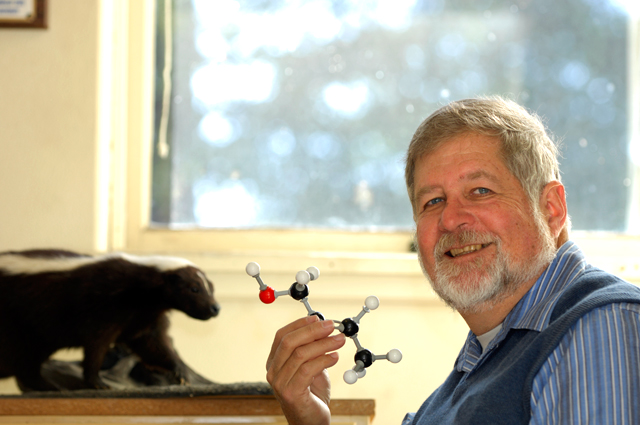
The show’s producers set out, in part, to show skunks in a different light. It turns out that a good many people in the U.S. actually keep the animals as pets—albeit with their odiferous glands removed. Prof. Wood might not go so far as to keep one as a pet, but he is quick to point out that after almost 20 years of researching the animals’ scent, he has never once been sprayed. “I’ve been out taking a walk and come upon one a few feet away. . . he had his tail up but I backed off. Dogs on the other hand—they go right for it.”
Dogs’ encounters with skunks are numerous enough to drive significant interest in how to remove the skunk smell from fur. Prof. Wood maintains a website on the chemistry of skunk spray, and he has popularized an effective neutralizer for the skunk scent. It calls for making a solution of hydrogen peroxide, baking soda, and detergent. Although highly effective, it can have one unintended consequence: lightening an animals’ fur. Prof. Wood has seen one instance of a black lab appearing more like a chocolate lab after the solution was applied.
Prof. Wood was the first to discover a new compound in skunk spray, called a thioacetate. Thiols are the sulfur-based compounds that are primarily responsible for skunk spray’s famous foul odor. “In low concentrations, sulfur is important in food,” he says. “As an example, there is a compound called methanethiol, which is in fresh coffee. When they made instant coffee, they found if they didn’t put it in, it didn’t taste quite right.”
It turns out that skunk spray can be seen as simply a highly developed communication technique. As Prof. Wood says, “In nature, those messages that chemicals convey can be attraction, like for mating—the sex pheromones. Or they can be a repellent, like skunks. Between members of different species—and skunks are the classic example—their scents’ chemical makeup says ‘Go away. Leave me alone.’”
The Nature program “Is That Skunk?” premieres Sunday, Jan. 25 on PBS. Visit PBS.org for your local listings.